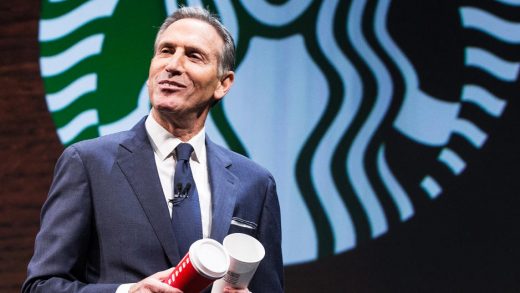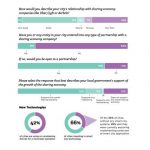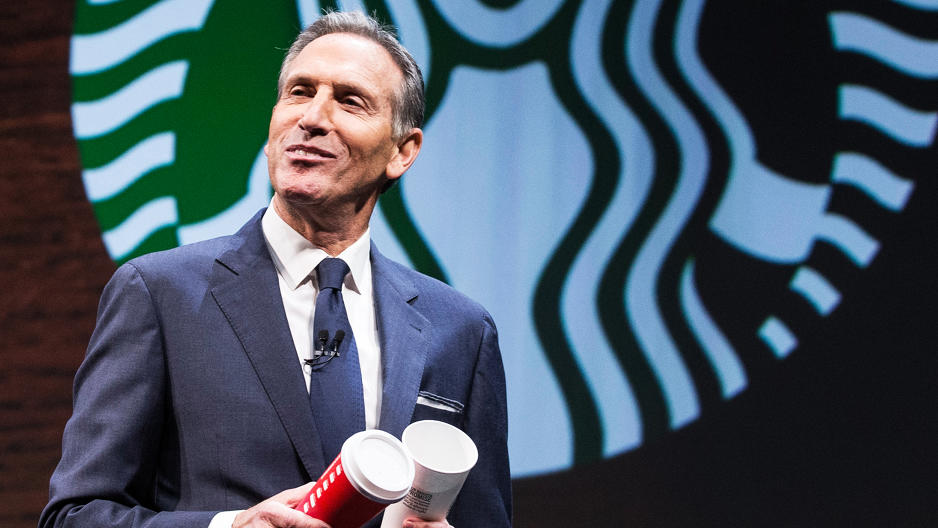How Starbucks Can Guarantee Its CEO Transition Succeeds
A company’s CEO is often the face of the brand. In the case of Howard Schultz, his mild countenance has become synonymous with the coffee company’s twin-tailed Siren that signals the presence of more than 25,000 shops in 75 countries.
Now, that face is planning to step aside. Starbucks announced last week that Schultz is transitioning to take the position of executive chairman while he works on expanding the company’s premium brand. Schultz “personally selected” Starbucks’ current president and COO Kevin Johnson to take the helm, which will happen on April 3, 2017.
Johnson, who the New York Times reported is a close friend of Schultz’s, has been on the company’s board of directors for seven years and on its executive management team since 2015. Yet Johnson has some big shoes to fill. Not only has Schultz presided over the expansion of the largest coffee business in the world, but he’s also never shied away from the company’s social responsibility or the care of its staff—which is why we pronounced him among the best leaders of 2015.
Confidence Must Come From The Top
Schultz is confident of Johnson’s abilities, saying he’s “better equipped” to “run the company than I am,” in the Times interview.
The nod to Johnson’s operational talents sends an important message, because the way a company manages such a major transition significantly impacts its financial performance, according to leadership consultancy DDI. Starbucks’ solid financial performance—it has consistently outperformed the S&P as well as other brands in food retail—hangs in the balance.
Dave Ulrich, a professor at the University of Michigan’s Ross School of Business, explained the pressure a new leader facesin a previous Fast Company article. He said:
To help weather [transitions], executives need strong track records of delivering measurable results amid uncertainty. At times when doubts run high, a CEO should reassure everyone watching that he or she has a plan that will pull through.
Practicing The Work
The good news is that Johnson has already taken over Starbucks’ day-to-day operations—a change the the company made this past summer—allowing for the two executives to overlap responsibilities. A DDI study of leadership in transition indicates that among over 600 professionals surveyed, close to half (42%) said they wanted a more structured development plan along with mentorship.
An essential part of a succession plan is this type of handoff, according to Patty Azzarello, CEO and business adviser at Azzarello Group. “You need to give them opportunities to practice the ugly, mind-numbing, controversial, boring, unsupported, failing, no-win kind of work you deal with every day when you wake up,” she wrote in Fast Company. The reason this is crucial, Azzarello said, is “they get to suffer like you do. But they get to work on big stuff. They get access to your network and stakeholders. They have the chance to do something creative and heroic to get this done.”
It remains to be seen how much Schultz will manage alongside Johnson. DDI found that many times a “former manager disengages, and the new manager—with a backlog of projects—fails to appreciate the challenges faced by the leader-in-transition.”
Acknowledge The Change, Set Expectations
Beth Bechky, who teaches courses in managing high-performance teams at New York University’s Stern School of Business, told Fast Company in a previous interview that when someone’s role is elevated, it’s easy for the team to assume nothing has actually changed. She recommends that leaders in transition acknowledge the changes and clearly communicate how expectations may be shifting.
Making Decisions And Being Authentic
Part of the shift in expectations could be realized through a new style of decision making. Advises Azzarello, “Think about the next few months of decisions you need to make. Investments, priorities, partnerships, roadmap choices, marketing strategies. Give your top performer the task of owning the project and making the decisions.”
Empathy And Authenticity
What may work in Johnson’s favor is his early display of vulnerability and authenticity, traits that translate to business success, according to DDI.
In the New York Times interview, Johnson acknowledged that he came back to the corporate world after a bout of skin cancer, convinced that Starbucks would give him the opportunity to do something meaningful. He also acknowledged his own self-doubt about the new role, but he carefully deferred to the company’s beloved chief. “I’m not going to try to be Howard,” Johnson said. “We are two different people.”
Such emotional intelligence and display of character bodes well for the future of the new CEO of Starbucks. According to KRW International, a leadership consultancy, CEOs whose characters were highly rated by employees had an average return on assets of 9.35% over a two-year period, almost five times as much as CEOs with low scores whose return on assets averaged just 1.93%.
Fast Company , Read Full Story
(67)













